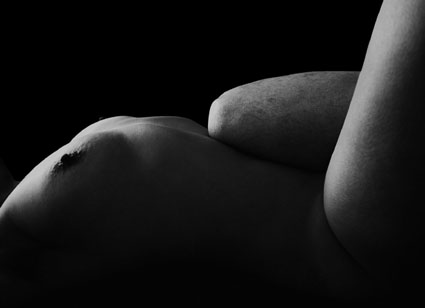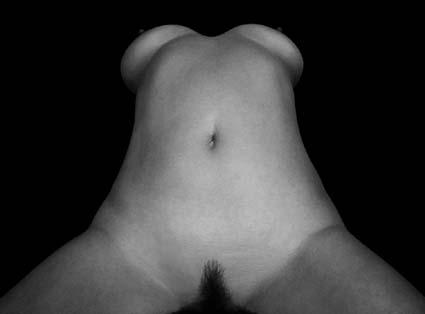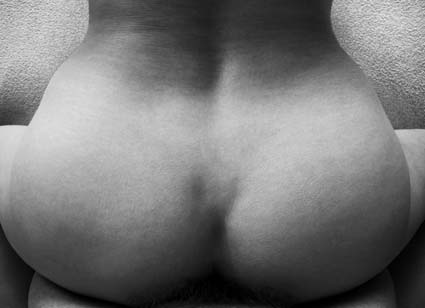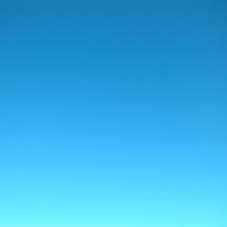AKT, TĚLO, EROTIKA, LÁSKA
Umění se z určitého pohledu jeví jako posun. Umělec vždy vychází z něčeho známého a fixovaného, ty souřadnice on potřebuje, aby mu bylo rozumět, a když se mu "zadaří", uskuteční posun směrem do neznáma. Cesty tohoto posunu jsou nespočitatelné a jen někdy známé. Cíle jsou málokdy předem dané, obvykle vznikají teprve společně s dílem. Výsledek posunu budívá obvykle o to větší pozornost, o co větší je posun. Je tu přímá úměra, ale sázet na ni nelze. V umění není hranic.
Posouvají se i celé žánry. Akt sehrál v průběhu staletí mnoho rolí. Byla to zejména nahá ženská postava, která se převlékala do všemožných historických a alegorických postav, do symbolů a idejí. V minulém století se ale nahota stala opět nahotou a pokud něco symbolizovala, byl to návrat k přírodě; nakonec zevšedněla, zcivilněla. Poslední velká proměna aktu souvisela s tělovým uměním, body-artem. Nahota jako by zmizela, zůstalo jen tělo. Když Tomáš Ruller v sedmdesátých letech začínal jako akční umělec, performer a body-artista, bylo pro něho tělo prostředkem.
Znal své tělo lépe než jiní. Od mládí praktikoval různá východní "umění" a postupně ohledával i další možnosti tvořit skrze tělo. Snažil se o to vždy i ve svých "piecech". Umění kromě jiného umožňuje zkušenost přesahu, vytržení, seznámení s neznámem. Často se Rullerovy pokusy neobešly bez velké odvahy.
Mezi současnými umělci patří Ruller k těm nejvšestrannějším. Využívá mnoha uměleckých a mimouměleckých oborů a forem. Také zacílenost jeho aktivit má svou polaritu. Až do poslední doby pokračuje autorova společenská angažovanost a snaha registrovat proměny civilizačních forem (například v práci s novými médii), ale stále častěji se objevují díla zakotvená snad v dětství a zprostředkující vytoužené zážitky čistoty, krásy, křehkosti, soběstačnosti forem a dalších jistot, které mohou být stále přítomné. Způsob, jakým se Ruller v posledních letech vrací k tělu, patří myslím k posledně uvedenému pólu jeho tvorby. Videoinstalace "Peep-art" mimo jiné pozoruhodně zhodnocuje známý paradox, že čím detailněji člověk zkoumá konkrétní skutečnost, tím víc se předmět abstrahuje ztrátou souřadnic iluzivního prostoru. Také vystavené digitálně zpracované fotografie jsou abstrahované. Snad nejvíc prozrazují autorovo sochařské školení a patří k výtvorům čisté krásy. V tomto ladění nejsou ve světě fotografie výjimkou (vzpomeňme třeba jen Roberta Mapplethorpa), ale jedinečné jsou již v tom, že zobrazují i kousek erotiky jako krásnou formu. Uskutečňují posun.
K dalším pozoruhodným aspektům Rullerových fotografií patří zveřejnění soukromí, i to že je zde tělo jako dřív nositelem aktivit, akce se však změnila v interakci, která osciluje někde mezi bezprostřední inspirací a inscenací, na poli life-performance. Fotografie zcela neztrácí dokumentárnost, ale zároveň je symbolem, jehož význam je třeba hledat někde v souřadnicích rituální kontemplace. A nejde vlastně o tělo, tělo zde slouží spiritualitě. V protikladu k dnešnímu konzumu tělesnosti jsou to povznášející díla meditativní krásy.
Antonín Dufek (Moravská galerie)
THE ACT, THE BODY, THE EROTIC, LOVE
From a certain viewpoint, art appears to involve something of a shift. The artist always sets off from a familiar and fixed point; one needs these co-ordinates in order to communicate his or her message, and "on a lucky day", they also perform a shift towards the unknown. There are countless means of shifting, and only some can be anticipated. Only sometimes are destinations determined beforehand; they usually unfold in the course of the artistic process. The greater the shift, the more attention its results stir. They are part of a direct proportion; a proportion, however, that cannot be counted upon. Art knows no limits.
Even whole genres shift. The nude has played many different roles over the centuries. Once it was predominantly a naked female figure dressed up as various historical and allegorical characters, symbols and ideas. In the 20th century, nakedness became nakedness once again, and if it symbolised anything at all it was a return to nature; finally it became over-prosaic and commonplace. The last major transformation of the nude involved body art, in which nakedness seemed to disappear and only body remained. When Tomáš Ruller started his career in the 1970’s as an action, performance and body artist, he approached body as a means.
Ruller knew his body better than most. He had been indulging in various kinds of "Arts of the East" since his youth, and came to explore further ways of creating through the body, ways that he has always practised in his "pieces". Among other things, art offers experience of outreach, trance, encounter with the unknown. Ruller’s efforts frequently required a great deal of courage.
Ruller is one of the most versatile contemporary artists. He employs many artistic disciplines and forms, as well as those outside art. The orientation of his activities also has its polarity. The artist’s social engagement continues: he strives to register changes in the forms of civilisation (for example, in work with new media). Yet works that possibly draw upon childhood experience occur more and more often; they mediate experiences for which one yearns, the purity, beauty, gentleness and self-containment of forms and other certainties that may always be present.
The manner in which Ruller has returned to the body in recent years belongs, in my opinion, with this last-mentioned category of his work. His Peep-art video installation, among other things, aptly illustrates the well-known paradox that the more closely we observe a concrete reality, the more abstract the object becomes, due to the loss of co-ordinates in an illusory space. The digital photographs on display are also abstract. They reveal much of the artist’s sculpture training, and are creations of pure beauty. Although this tone is not exceptional in the world of photography (Robert Mapplethorpe and others), Ruller’s photographs are unique for their representation of a touch of eroticism as a form of beauty. They accomplish a shift.
Other remarkable aspects of Ruller’s photographs include the publicising of privacy; the body is still the agent of activity but the action has changed into interaction, oscillating between spontaneous inspiration and staged photography, in the sphere of life-performance. The photographs do not lose their documentary value completely; at the same time, they are symbols, the meaning of which is to be sought in the realm of ritual contemplation. In fact, body is not crucial here; it serves spirituality. In sharp contrast to the carnal consumerism of today, these are uplifting works of meditative beauty.
Antonín Dufek (Moravian Gallery)
NA LÁSKY ČAS / OF LOVE´S TIME
